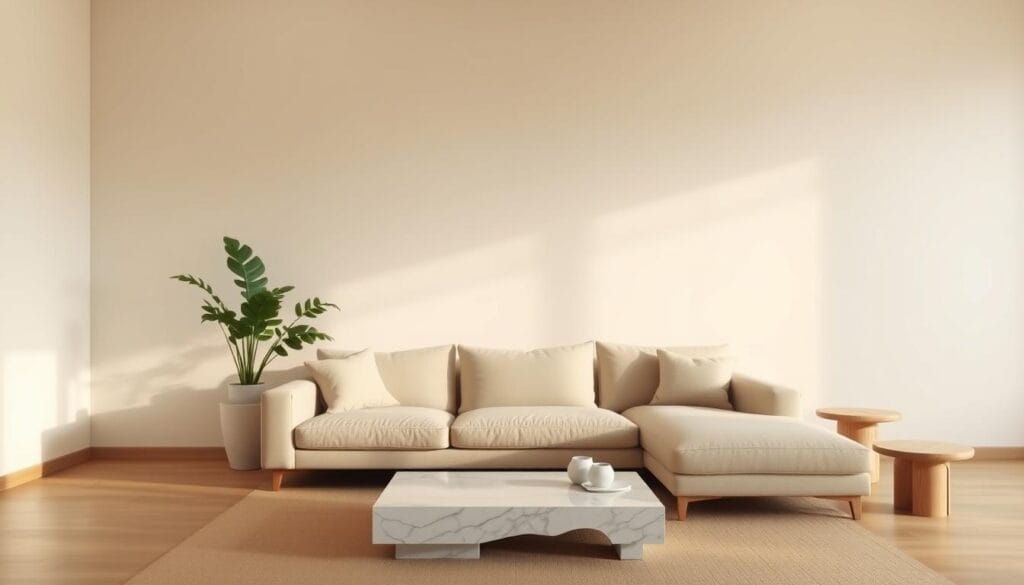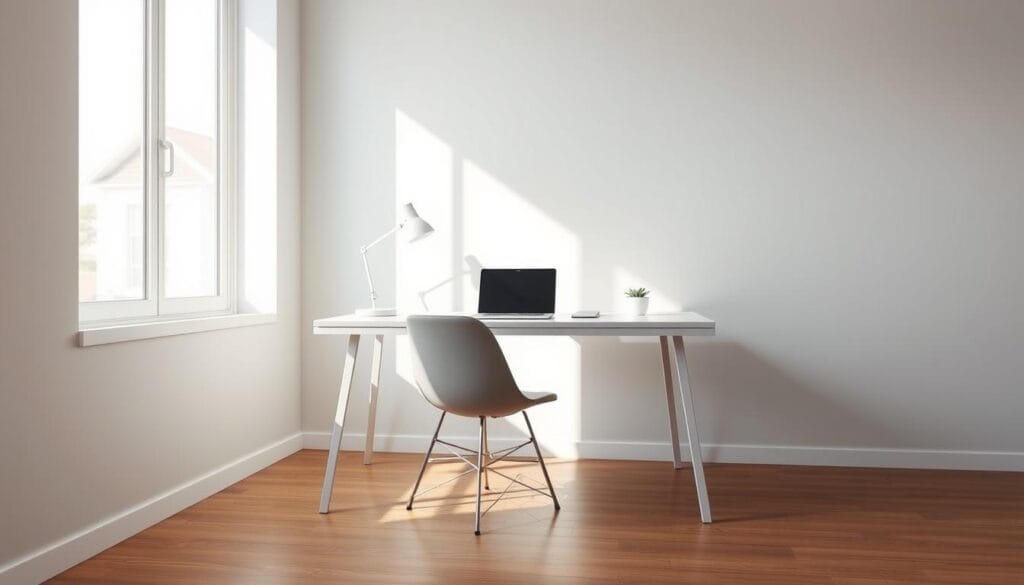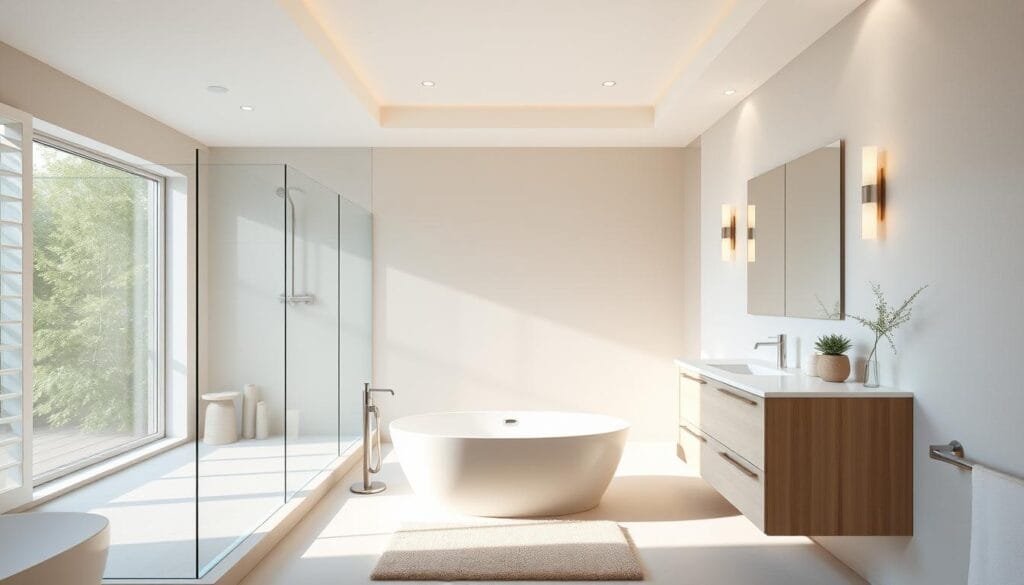Have you ever entered a room that felt perfectly calm because of its simplicity? 🛋️ Imagine a space organized so well, where everything has its spot. There’s a special balance between being cozy and stylish. That is what minimalist interior design is all about. It truly shows that “less is more.”
This design style started in the 1960s and 1970s, from the minimalist art movement after World War II. It’s fascinating how it grew from needing simplicity to becoming a timeless trend. If the midcentury-modern or international styles have caught your eye, then you’ve felt the minimalism touch.
Ludwig Mies van der Rohe said “less is more,” and it wasn’t just about buildings. He was sharing a bigger idea. Minimalist decor focuses on simple lines, soft colors, and the beauty of being understated. Imagine your space being as inviting and open as a gallery, filled with light and peace.
Minimalist living is more than looks; it’s about making a balanced space. As someone who chose this minimalist path, I’ve learned it’s about keeping things that truly matter. This way of life supports sustainability by avoiding too much stuff. It’s about making careful, meaningful choices.
If you’re drawn to the calm look or the practicality of minimalist design, we’re here to help. Ready to turn your place into a minimalist haven? Let’s explore how to make your minimalist interiors both beautiful and useful. 🌟
Understanding Minimalist Interior Design
Welcome to the world of minimalist interior design! 🌿 It loves simplicity and being clutter-free. It uses clean lines and neutral colors. Starting in the early 20th century, it has grown into a timeless look that continues to uplift and calm us.
The Concept of Minimalism in Design
Minimalism in design means “less is more.” It’s not just a cool phrase—it’s about living simply and functionally. Think of rooms in whites, grays, and earth tones. These colors help make a calming space that minimalist designs are famous for. Picture the peaceful feel of a MUJI Hotel room, with natural materials and a soft color palette.
Key Principles of Minimalism
Minimalist design focuses on simplicity, functionality, and careful choice. It features furniture with clean lines, like the Nara Sofa or the Grant Sectional. They look good and work well. Minimalist rooms choose quality over quantity, using just a few standout pieces. The MUJI Hotel is a great example, using natural elements and lots of light to make spaces welcoming and clear.
Benefits of Minimalist Interior Spaces
A minimalist style is great for your mind and body. Studies show that less clutter can boost focus and productivity by about 30%. Also, having fewer things means spending less time cleaning! Plus, minimalist rooms use lasting materials like wood and stone, connecting you to nature and lasting longer. Scandinavian minimalism, used in 60% of minimalist homes today, does this by choosing natural designs.
This shift to simple living is becoming more popular, with sustainable brands like Maiden Home and West Elm growing about 15% each year. People find that living minimally doesn’t just create a lovely, usable home. It also cuts down on waste and costs.
Essential Elements of Minimalist Interiors
Minimalist interiors focus on the beauty of simplicity and a calm feel. We examine three key elements in this design style: a minimalist color palette, carefully chosen furniture, and proper lighting to boost the mood.
Color Palette Choices
The base of minimalist interiors is the color palette. Neutral colors like white, beige, gray, and black are common. These colors not only make the atmosphere calming but also allow easy decor changes. A minimalist color palette makes your space feel larger and brighter by reflecting light well.

Furniture Selection
In minimalist furniture, “less is more” stands true. Choose pieces with clean lines and simple forms for a clean look. It’s good to pick furniture that does more than one thing. For example, a sofa that turns into a bed or a coffee table with hidden storage helps keep your area tidy and simple.
| Type of Furniture | Functionality | Minimalist Features |
|---|---|---|
| Sofa | Sitting & Sleeping | Clean lines, neutral colors, multi-functional |
| Coffee Table | Storage & Surface | Hidden storage, simple shapes |
| Dining Table | Eating & Working | Streamlined design, natural materials |
Lighting and Ambiance
Good lighting is a must in minimalist design. It emphasizes natural light to make areas feel open and airy. Add soft artificial lights that spotlight without taking over. Minimalist light fixtures often have simple designs. They help keep the space calm and tidy.
Space Planning for Minimalist Design
Effective space planning is key for minimalist design. It aims to make living areas open, easy to move around in, and nice to look at. Through careful planning, we achieve a mix that boosts both comfort and style.
Creating Open Spaces
Creating open minimalist spaces means more openness and peace. We use natural light, choose simple furniture, and limit decorations. This results in a clean, calm place that’s perfect for relaxing.
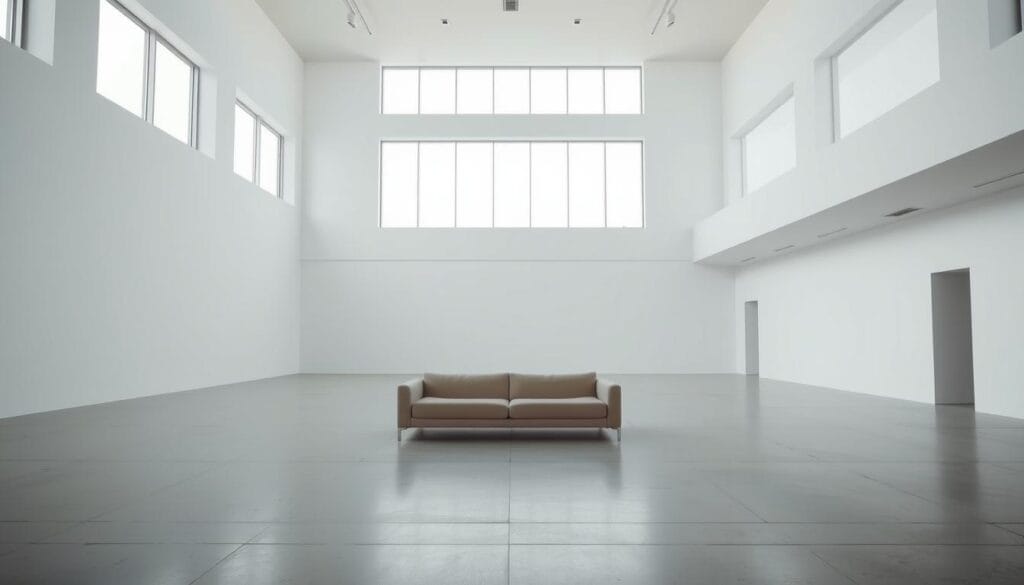
Natural materials like wood and stone are essential in minimalist style. They add beauty and comfort without making the space feel crowded. Also, smart space planning means less bulky furniture and decor, showing that “less is more”.
Functional Layout Considerations
Functionality is vital in your home’s layout. Every part of your house should have a clear purpose and be able to change for different uses. Items like expandable tables and storage ottomans are smart choices because they’re useful and look good.
Every piece in a minimalist space should be practical. This approach means you’ll have fewer items, making your home neater and more peaceful. For example, kitchens look better with hidden storage and bathrooms feel spa-like with simple color schemes.
In minimalist design, it’s all about smart decisions that focus on good quality and less stuff. Choosing and placing your furniture well makes your home inviting, useful, and attractive. Remember, minimalist living is not just simple. It’s also about having a space that’s spacious and cozy.
Choosing the Right Materials
When you’re setting up a minimalist home, the materials you pick are very important. They can make your home feel warm and real, or modern and smooth.
Natural vs. Manufactured Materials
Natural and manufactured materials each bring something different to a minimalist space. Natural materials like wood, stone, and bamboo add authenticity. They make your space warm and peaceful. Popular natural choices for furniture and flooring include woods like beech and ash.
Marble or travertine stone, on the other hand, is great for countertops. These choices are not only eco-friendly but durable too. They fit the minimalist style well.
On the flip side, materials like stainless steel, brushed aluminum, and glass offer a modern look. These help make a space feel neat and organized. For instance, metal fixtures can add a contemporary vibe. Big glass panels without frames also help bring in more light, making rooms feel bigger.
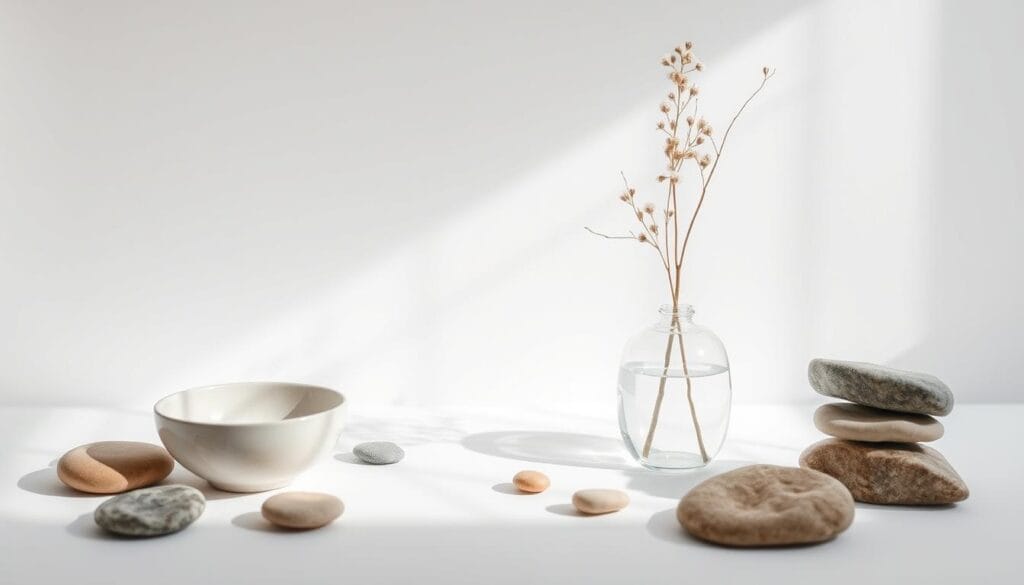
In the end, it’s really about what you like and the vibe you want to create. Natural materials can make your space calming and are good for the planet. But manufactured materials can also give your space a sleek, stylish look easily.
Texture and Finish Choices
In minimalist decor, the texture and finish of materials matter a lot. Using subtle textures can lift up the space without making it feel too busy. Textures like linen, cotton, or wool add a soft touch.
This helps keep the room comfortable yet simple. Sticking to one or two neutral colors is also key to keeping everything looking together.
When it comes to finishes, matte and satin are often picked over glossy. They bring elegance without the shine. Light woods and neutral stones are ideal for a minimalist look. They create an organic feel. These choices ensure that every part of the room fits well together.
| Material Type | Examples | Advantages | Common Uses |
|---|---|---|---|
| Natural | Wood, Stone, Bamboo | Authenticity, Warmth, Sustainability | Furniture, Flooring, Countertops |
| Manufactured | Stainless Steel, Brushed Aluminum, Glass | Uniform Look, Modern Aesthetic | Fixtures, Hardware, Panels |
| Textures | Linen, Cotton, Wool | Softness, Tactile Appeal | Fabrics, Upholstery |
| Finishes | Matte, Satin | Understated Elegance | Paint, Wood Treatments |
In summary, the right materials and finishes are essential for a minimalist home. They help create a space that’s both balanced and peaceful. Whether you like the warmth of natural items or the clean look of manufactured ones, your choices reflect your style.
Mastering Minimalist Color Schemes
The minimalist color palette is key in minimalist interior design. It helps create a calm and open feeling in any room. White, gray, beige, and taupe are the main colors used, making spaces feel light and peaceful.
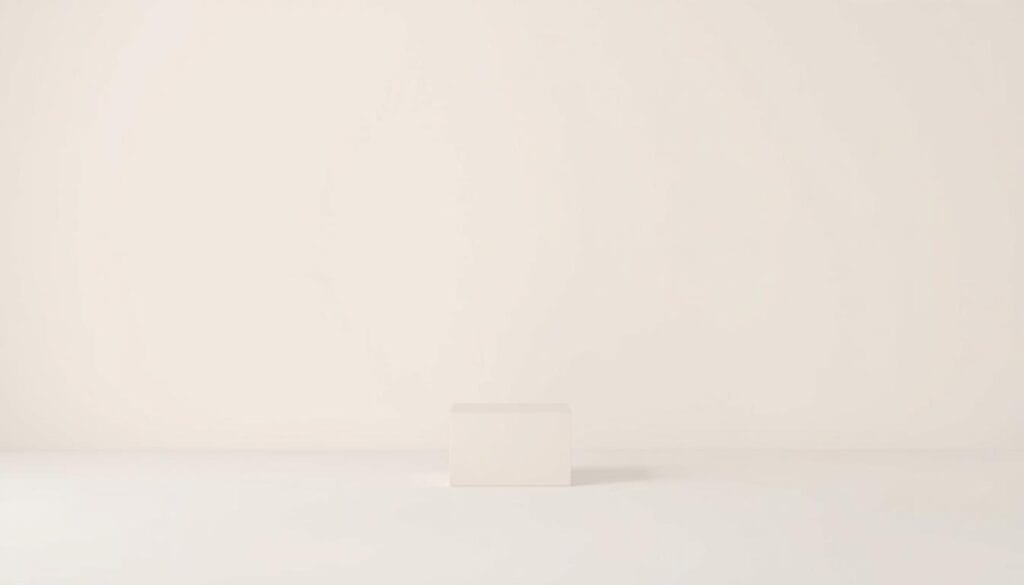
Neutral Tones and Their Impact
Neutral tones are vital for a minimalist look because they make a place feel calm and clean. Using white, gray, and beige can make any room look bigger and brighter. These colors are a background that lets other room features stand out beautifully.
In bedrooms, colors like warm beige, pale blue, or lavender are chosen for a good night’s sleep. They are comforting and help you relax.
| Room Type | Recommended Neutral Tones |
|---|---|
| Living Room | White, Gray, Beige |
| Bedroom | Pale Blue, Lavender, Warm Beige |
| Kitchen | White, Gray, Pale Wood |
Adding Pops of Color
Although minimalist designs love neutral colors, a bit of color can make a space lively. Soft accents like pale blues, greens, and blush pinks bring depth without overpowering. They add interest quietly.
In kitchens and dining areas, white and gray mix well with pale wood for a welcoming feel. Adding color through art, textiles, or decor keeps the space interesting and clear.
Incorporating Art and Decor
Integrating art and decor into a minimalist space focuses on quality over quantity. The aim is to choose meaningful pieces that enhance the area. This method keeps the minimalist design’s clean look and spacious feel.
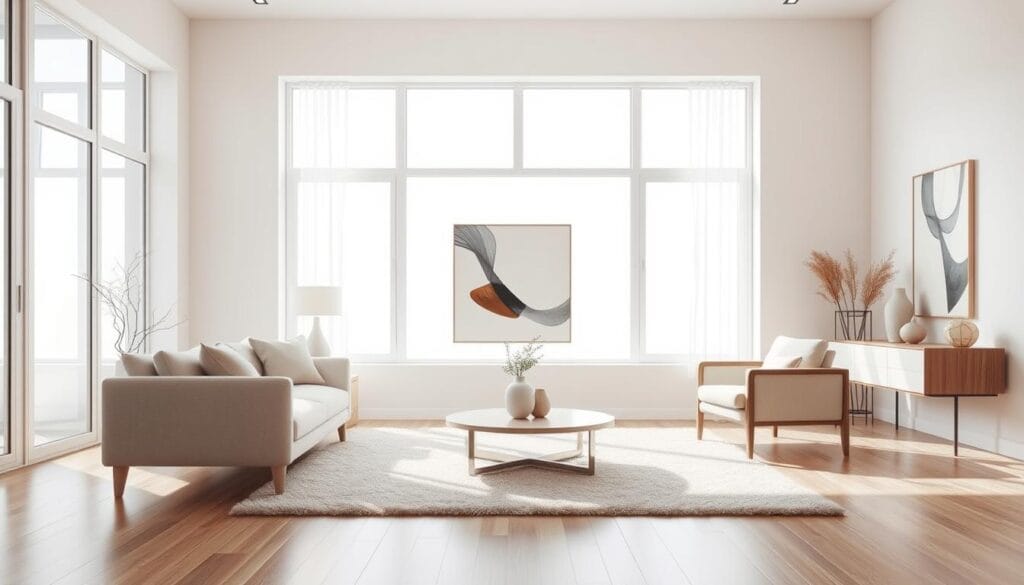
Selecting Quality Over Quantity
Choosing art that speaks to you is fundamental in minimalist decor. It’s better to have a few items that are high-quality than many that crowd your space. A study showed that 70% of customers prefer investing in unique, minimalist-friendly pieces. Adding abstract art can make your space look better, which 60% of interior designers agree with.
The Role of Negative Space
Negative space, or the empty areas around items, is important in minimalist decor. It allows each piece to stand out and keeps everything balanced. Research indicates that negative space can make living areas more functional and peaceful. Half of the people surveyed felt better in minimalist spaces because of this approach. It keeps your area tidy and attractive.
| Statistic | Percentage |
|---|---|
| Clients preferring clean lines and neutral tones | 75% |
| Designers recommending abstract art for minimalism | 60% |
| Homeowners finding minimalist homes calming | 50% |
| Clients willing to invest in unique decor pieces | 70% |
| Effectiveness of using negative space | 50% |
When thinking about minimalist decor and art, it’s clear that the right balance is essential. By choosing decorations wisely and using negative space well, you can create peaceful and useful interiors.
Lighting in Minimalist Design
Lighting is key in making minimalist design work well. It makes spaces feel open and airy, yet focused. We’ll look at natural and artificial light, and how big light pieces can add charm but keep things simple.
Natural vs. Artificial Lighting
Natural light is a big deal in minimalist lighting. Big windows and skylights bring in a lot of daylight. This makes rooms feel welcoming and bigger. It also shows off the simple materials and lines of minimalist design. Plus, it cuts down on the need for artificial lights during the day.
Artificial lighting aims for simplicity and usefulness. LED bulbs work great in minimalist homes. They are good for the environment and last a long time. Lights like wall sconces and pendant lights give good general and specific lighting. These fixtures fit right in with minimalist design.
Statement Light Fixtures
“Less is more” is a key idea in minimalist design. Yet, it still uses bold pieces to make a statement. A standout pendant light can really elevate a space. It draws attention without adding clutter.
Pick fixtures in neutral colors to match a minimalist look. Use dimmers to change the light for different needs. This way, you can create a calm and attractive space that showcases minimalist lighting well.
| Lighting Feature | Description |
|---|---|
| Natural Light | Maximized through large windows and skylights, enhancing openness. |
| Artificial Light | High-performance LEDs and strategic fixtures for efficient illumination. |
| Statement Fixtures | Focal points that add character while maintaining a clutter-free aesthetic. |
Organizing Your Minimalist Space
Keeping your minimalist space tidy is key. It’s all about being clear and purposeful, making sure everything has its place. Energy needs to flow freely in open spaces. Here are some practical tips to create and keep a peaceful balance.
Decluttering Tips
Getting rid of clutter is essential. Begin with simple steps: review and remove things that are not useful or joyful. Using the “one in, one out” rule helps avoid clutter buildup. Cleaning out every few months keeps your space fresh and focused.
Also, think about what you buy. Buying with intention helps keep your space minimalist, as we tend to get about 70 new things a year. By evaluating what you own often, you keep only what’s important. This approach helps clear your mind and reduces stress.
Storage Solutions for Minimalism
Smart storage is vital for a minimalist look. Start with modern modular shelves and sliding shelves to use space better. These ideas can help hide stuff neatly while keeping it within reach.
Try furniture that does more than one thing, like beds with drawers. This way, you don’t need big dressers or nightstands. Adding cabinets from floor to ceiling also increases storage and keeps things tidy. These tips help minimize clutter.
Good storage options and minimalist design make your home both useful and beautiful. By following these tips, you’ll have a tidy, calm space that highlights the beauty of less.
Tips for Maintaining a Minimalist Aesthetic
Choosing a minimalist interior design means focusing on both looks and usefulness. It’s crucial to have easy, but regular, cleaning habits. This stops clutter from building up, keeping your space peaceful and tidy. The interest in living simply has grown about 30% in the last five years. More people now see the value in having less but meaningful stuff.
Regular Housekeeping Routines
One great way to keep a minimalist look is by cleaning regularly. Minimalist homes look less cluttered by about 25% when kept tidy. It’s about keeping things in order, not just cleaning. Make time every day to clear up. This keeps surfaces clean and spaces open, making the room feel bigger by 30%. Minimalism helps clear your mind and lowers stress by up to 40%. Finding good ways to store things is important, too. 55% of people in a design study said proper storage helped them keep clutter off surfaces.
Evolving Your Space Over Time
Minimalist places should change as you do. Check if each item is still needed or makes you happy. About 70% of people changing to minimalism look for items that are simple and useful. A study found that 80% of minimalist designers think keeping walls clean and spaces open is critical. By choosing textures and a standout piece wisely, you can add interest without clutter. This keeps your home looking fresh and calm, making it a stylish, stress-free retreat.
Following these suggestions will help you keep a minimalist interior design that’s both calming and practical. With regular cleaning and updating your space smartly, you’ll keep enjoying the peacefulness a minimalist style offers.

